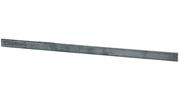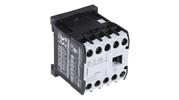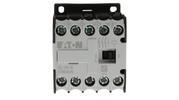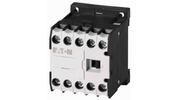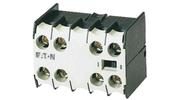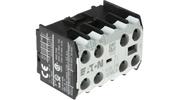Работаем с юридическими лицами, бюджетными организациями, ИП
По вопросам приобретения товара пишите на info@west-cs.ru
Eaton Contactors - DILEM & DILEEM Series_x000D_
Eaton's range of DILEM & DILEEM contactors are predominantly used in larger-scale operations, they are designed to provide a long mechanical and electrical life which in turn accomplishes reliability. Users will commonly find these contactors integrated within industrial buildings and factory installations, enabling automated processes of motors and resistive loads_x000D_
Features & Benefits_x000D_
Easier engineering through identical construction sizes for AC- and DC-operated contactors_x000D_
Energy savings and higher packing density in control panel due to minimized heat dissipation_x000D_
High wiring security through doubled box terminals_x000D_
Less coupler relays: direct actuation from the PLC for contactors up to 32 A_x000D_
Easy engineering through integrated suppressor circuits for DC_x000D_
Wide operating temperature_x000D_
Surface or DIN rail mounting_x000D_
Ingress Protection Rating of IP20 on the contacts protecting against solid objects up to 12mm, - has no protection against water_x000D_
Mechanical Interlock for use with DILE* Series 326-740 (does not prevent fitting of auxiliary contact blocks)_x000D_
How contactors operate?_x000D_
If you have asked yourself this question, rest assured you are not the only person that has wondered how contactors work. If you've wondered how do contactors differ from a relay? The following answer will also explain that. A contactor is essentially a relay, it holds very similar functions, but it is typically used in larger-scale applications. In most cases, a contactor is a switch that can be controlled remotely, specifically designed to switch a large amount of electrical power through its contacts._x000D_
Eaton DILEM-10(230V50HZ,240V60HZ) Contactor_x000D_
Eaton's range of DILEM & DILEEM contactors are predominantly used in larger-scale operations, they are designed to provide a long mechanical and electrical life which in turn accomplishes reliability. Users will commonly find these contactors integrated within industrial buildings and factory installations, enabling automated processes of motors and resistive loads._x000D_
Features and Benefits_x000D_
3 pole_x000D_
Conforms to IEC/EN 60947, VDE 0660, CSA, UL standards_x000D_
The ambient operating temperature when open is - 25 - 50°C_x000D_
The ambient operating temperature when enclosed is - 25 - 40°C_x000D_
Weighs just 0.17kg_x000D_
Forms part of the DILEM contactor range_x000D_
Utilisation category - AC-1: Non-inductive or slightly inductive loads, resistance furnaces, NAC-3: Normal AC induction motors: starting, switch off during running and AC-4: Normal AC induction motors: starting, plugging, reversing, inching_x000D_
Also suitable for motors with efficiency class IE3_x000D_
Screw terminals_x000D_
With auxiliary contact_x000D_
For use with the DILEM and DILEEM range_x000D_
Has an actuating voltage of 230 V 50 Hz, 240 V 60 Hz_x000D_
Typical Applications_x000D_
This range of contactors can be used across a multitude of applications, users will commonly find these contactors being used within factory automation, railway transportation, electrical systems, starting motors, providing control over furnaces and mechanical engineering._x000D_
How contactors operate?_x000D_
If you have asked yourself this question, rest assured you are not the only person that has wondered how contactors work. If you've wondered how do contactors differ from a relay? The following answer will also explain that. A contactor is essentially a relay, it holds very similar functions, but it is typically used in larger-scale applications. In most cases, a contactor is a switch that can be controlled remotely, specifically designed to switch a large amount of electrical power through its contacts.
Наш менеджер свяжется с вами в ближайшее время


